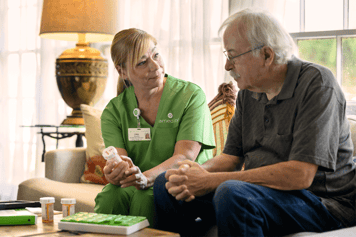One of the most common questions about hospice care is, “how long can someone be on hospice?” Understanding the duration and criteria for hospice can help patients and their families make informed decisions during challenging times.
While most patients only experience its benefits for days and weeks, hospice is available when a patient’s physician certifies that they have six months or less to live, as explained further below, with recertification available if the patient outlives that six-month period and continues to meet hospice criteria.
What is Hospice Care?
Hospice is defined as supportive care that focuses on comfort and quality of life. Hospice is available for patients with a terminal illness and a life expectancy of six months or less if their illness runs its normal course, as certified by a physician.
Hospice services include:
- Skilled nurses making intermittent visits to assess the patient, provide care and coordinate care from other disciplines.
- Hospice aides to support activities of daily living.
- Medical social workers to support the patient and family and make connections to community resources.
- Chaplains for spiritual support.
- Hospice volunteers for companionship and support.
- Bereavement support for the family for up to 13 months following the patient’s passing.
Some companies like Amedisys also offer specialized programs to care for certain diagnoses like dementia, heart failure and more.
Eligibility Criteria for Hospice
Understanding how long hospice care can be provided first starts with having a strong grasp of the eligibility criteria.

To be eligible for hospice, the patient must be considered terminally ill with a life expectancy of six months or less if the disease runs its normal course, as certified by a physician. 1 Hospice physicians use their clinical expertise and information from a comprehensive assessment to determine life expectancy. Signs the patient is declining from the terminal illness include progressive weight loss, frequency of hospitalizations, increasing weakness or fatigue, difficulty with daily activities and more.
The patient must also elect to stop curative treatments in favor of the comfort and quality of life measures hospice provides. The physician will work closely with the hospice care team on a personalized plan of care focused on pain and symptom management and comfort so patients and families can make the most of their remaining time together.
How Long Can Patients Receive Hospice Care?
Patients can receive the benefits of hospice care as long as they continue to meet the eligibility criteria. If a patient lives longer than the original six-month certification period, physicians can re-certify them to remain on hospice care if the disease progression still indicates a life expectancy of six months or less.
Although patients cannot receive curative treatment while on hospice care, if a patient’s condition improves significantly so that they are no longer considered terminally ill, they will be discharged from hospice care. Patients can also choose to opt out of hospice care at any time during the service. 2
One of the most famous examples of how hospice can extend beyond six months is former President Jimmy Carter. President Carter received hospice care for nearly two years prior to his passing in 2024 — spending that precious remaining time with his family in his home. His legacy will be one of normalizing end-of-life conversations, sparking hope that more patients and families will seek out the benefits of hospice and embrace them sooner rather than later.
.jpg?width=609&height=406&name=Website%20Photos%20(23).jpg)
How Long Does Medicare Pay for Hospice Care?
The Medicare hospice benefit fully covers the cost of care for eligible patients receiving care from a Medicare-certified hospice provider. 3 As long as a patient has been certified (or re-certified) by a physician as eligible for care, Medicare will pay for hospice care.
What are the Benefits of Hospice Care?
One of the most common phrases we hear from families is, “we wish we had chosen hospice sooner.” By accepting help early, patients and families can expect a range of benefits at the end of life:
Pain and Symptom Management
Pain and symptom management is a central tenant of hospice care, providing comfort and the best quality of life possible for patients at home. Hospice care combines pharmacological and non-medication tactics to manage physical, emotional, psychosocial and spiritual pain for the patient and caregiver.
Holistic Care
Hospice is a unique Medicare benefit providing care with a full, interdisciplinary care team. Holistic care is a patient-centered approach that focuses on caring for the whole person, including their physical, emotional, psychosocial, and spiritual well-being.
Supportive Care Environment
Having hospice care at home fosters a sense of security, familiarity and peace, which can contribute to a patient’s overall sense of well-being.
Advance Care Planning
Hospice care encourages open communication and advance care planning discussions, allowing patients to express their desires for the final weeks and months of their life. This can help avoid unwanted medical interventions that could diminish quality of life by ensuring patients are getting the care they need and want.
How Do You Know When It’s Time for Hospice?
-
If you’re caring for a loved one with a terminal diagnosis, there are several key signs that it may be time to start talking about hospice care:
- Their doctor has given a prognosis of six months or less.
- Their health or disease symptoms are worsening with frequent trips to the hospital or doctor’s office.
- They have decreased appetite or pain/nausea interfering with their ability to eat and drink.
- They sleep more throughout the day and night.
- There are noticeable behavior changes in mental clarity, confusion, forgetfulness, or irritability.
- Activities of daily living like feeding oneself, bathing and dressing independently become more difficult.
- Caregivers are overwhelmed and unable to manage care on their own.
- Treatment is no longer working and/or aggressive intervention is no longer wanted.
.jpg?width=1920&height=1080&name=Blog%20Graphic%20Callouts%20(12).jpg)
What Are the Four Levels of Hospice Care?
As you research hospice, you may come across different levels of hospice care. Moving into different levels can be triggered by changing circumstances or needs of the patient or caregiver. Here are the four levels of hospice care all Medicare-certified agencies provide:
Routine Home Care
This is the most common type of hospice care. The full team conducts intermittent visits wherever the patient calls home, providing a comfortable and familiar environment.
Respite Care
Respite care is available when caregivers need a break. Patients are admitted to a long-term care facility or other inpatient facility with 24-hour nursing available. The patient can stay in the facility for up to five days/five nights and returns to routine level of care on day 6. The hospice team coordinates the plan of care and can arrange transport patients to and from the facility as needed.
Continuous Home Care
This level of care is for short-term urgent healthcare needs or symptom crises that can still be feasibly addressed at home. The hospice team provides at least eight hours of care within a 24-hour period. When symptoms are controlled, the patient returns back to routine care.
General Inpatient Care
If pain and symptoms related to the patient’s terminal illness can no longer be controlled at home, the patient may be appropriate for General Inpatient (GIP) care. The hospice team facilitates the patient’s transfer to a hospital, long-term care facility or hospice inpatient unit and will continue coordinating the plan of care. Patients will return home to routine home care once pain and symptoms are managed.
How to Get Started with Hospice Care
If you’re ready to start talking about hospice care with your family, Amedisys is here to support you through every stage. You can complete our hospice care assessment quiz to help determine eligibility, complete the form below to speak to a hospice specialist or call a location near you.
Deb Gallaher, MBA, MSN, RN, NE-BC, CHPN, is a Senior Hospice Clinical Education Specialist for Amedisys. She has 10 years of experience in hospice and is passionate about sharing her insights on high-quality care.
references |





